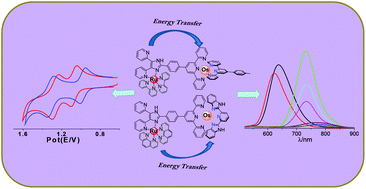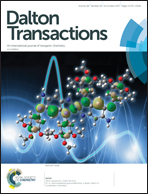Ru–Os dyads based on a mixed bipyridine–terpyridine bridging ligand: modulation of the rate of energy transfer and pH-induced luminescence switching in the infrared domain†
Abstract
A series of heterobimetallic complexes of compositions [(bpy/phen)2Ru(dipy-Hbzim-tpy)Os (tpy-PhCH3/H2pbbzim)]4+ (bpy = 2,2′-bipyridine, phen = 1,10-phenanthroline, tpy-PhCH3 = 4′-(4-methylphenyl)-2,2′:6′,2′′-terpyridine and H2pbbzim = 2,6-bis(benzimidazole-2-yl)pyridine)), derived from a heteroditopic bpy-tpy bridging ligand, were synthesized and thoroughly characterized in this work. The heterometallic complexes exhibit two successive one-electron reversible metal-centered oxidations corresponding to OsII/OsIII at lower potential and RuII/RuIII at higher potential. All the four dyads exhibit very intense, ligand centered absorption bands in the UV region and moderately intense MLCT bands in the visible region. The dyads also show intense infrared emission with the emission maximum spanning between 734 nm and 775 nm with reasonably long room temperature lifetimes varying between 30 ns and 104 ns. Both steady state and time resolved luminescence spectroscopic investigations indicate that efficient and fast intramolecular energy transfer from the 3MLCT state of the Ru(II) center to the Os-center takes place in all the four dyads. In addition, the rate of energy transfer was found to depend on the terminal ligand on the Os-site. Due to the presence of a number of imidazole NH protons in the dyads, significant modulation of both the ground and excited state properties of the complexes was made possible by varying the pH of the solution. By varying the terminal ligand, pH-induced “on–off”, “off–off–on” and “on–off–on” emission switching of the complexes was nicely demonstrated in the infrared region.



 Please wait while we load your content...
Please wait while we load your content...